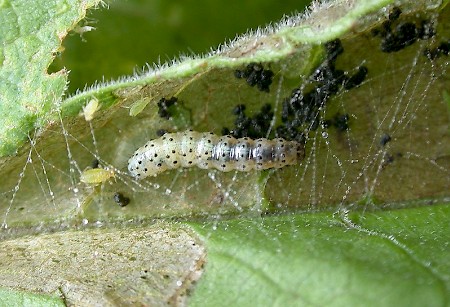47.005 BF483
Epermenia chaerophyllella
(Goeze, 1783)
Wingspan 12-14 mm.
A rather variable but distinctive species, with its raised scale-tufts visible when at rest. The moth is a mixture of blackish, chestnut and white in variable amounts.
It is rather common throughout the British Isles and occurs in two or three generations, with the last generation overwintering as an adult.
The larvae feed on umbelliferous plants, perhaps most often hogweed (Heracleum sphondylium) but also wild parsnip (Pastinaca sativa) and angelica (Angelica sylvestris) among others. In later instars the larvae feed gregariously on the underside of the leaves, creating distinctive feeding windows.
Larva: (description Ian F. Smith)
Foodplants: Three or more generations lasting two weeks each, May to September, at first mining then 'windowing' leaves of Heracleum sphondylium, Pastinaca sativa, Anthriscus sylvestris, Angelica sylvestris and Daucus carota. Usually below 170 metres a.s.l.
Length: 7 mm described.
Head: Pale brown. Epicranial spheres have blackish or dark brown mark laterally and subdorsally. Mouthparts darker reddish brown. Stemmata and stemmatal area black.
Prothoracic shield: Light translucent brown, with large blackish or dark brown marks bordering the wide dividing medial line.
Thoracic legs: Black or dark brown.
Body: Translucent shiny. Whitish (on Heracleum), amber (on Daucus), or greenish (MBGBI). Opaque white dorsal line of varying intensity.
Spiracles: Peritreme blackish, surrounded by large opaque white wart.
Pinacula: Black.
Setae: Black.
Anal plate: Concolorous with body. Black setal spots.
Prolegs: Concolorous with body. Planta almost transparent.
Pupa: In an open mesh silk cocoon. Usually on ground, but sometimes on underside of leaf.
Similar species:
Larva of 484 Epermenia aequidentellus on Daucus carota has a dark dorsal line and a black head. E. aequidentellus is confined to near the south coast of England. 478 Phaulernis fulviguttella on seeds of Heracleum sphondylium and Angelica sylvestris has grey pinacula and a brownish subdorsal line.

 UKMoths
UKMoths 








